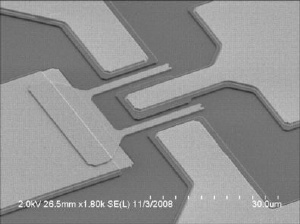Dec 5 2008
HRL Laboratories, LLC, demonstrated the first graphene field-effect transistors (FETs) using epitaxial graphene film operating in the radio frequency (RF) range. Prior efforts with graphene FETs used exfoliated graphene films. The HRL milestone is a key step toward wafer-scale high-speed RF FETs, which could lead to a new generation of carbon-based RF integrated circuits for ultra-high-speed, ultra-low-power applications.

HRL Laboratories, LLC, announced today it has demonstrated the world's first graphene RF field effect transistors (FETs) as part of the Carbon Electronics for RF Applications, or CERA program. The milestone is the first in the proposed 51-month, three-phase program to develop a new generation of carbon-based radio-frequency (RF) integrated circuits for ultra-high-speed, ultra-low-power applications.
The goal of the effort, sponsored by the Defense Advanced Research Projects Agency (DARPA) and under the management of the Space and Naval Warfare Systems Center (SPAWAR), is to exploit the unique qualities of graphene carbon to create components that will enable unprecedented capabilities in high-bandwidth communications, imaging, and radar systems. HRL is collaborating with a group of universities, commercial companies and the Naval Research Laboratory (NRL) on the program.
While graphene FETs have been demonstrated before, most used exfoliated graphene films. "HRL, working with the NRL, demonstrated graphene FETs using epitaxial film operating in the RF frequency range," said Jeong-sun Moon, Senior Research Scientist with the Microelectronics Laboratory at HRL. "This is a key step toward wafer-scale high-speed graphene RF FETs that operate in the RF domain."
The military's ability to develop sophisticated imaging and communications systems is hindered by RF component cost, limited resolution, and high power dissipation. A graphene-on-Silicon platform could revolutionize a number of military applications because of its high performance, scalability, integration and low cost.
Graphene is a single layer of carbon atoms densely packed in a honeycomb crystalline lattice configuration--like chicken wire on an atomic scale. The advantages of this configuration are its high current-carrying capacity, excellent thermal conductivity and low-voltage operational potential.
Moon said the current results are very promising. "The next step will be to continue to optimize material synthesis and device processing to see if we can harness the unique properties of graphene to make a new generation, state-of-the-art technology for future high-speed, low-cost military RF systems-on-chips," he said.
In upcoming phases of the project, the HRL team will fabricate FETS on 100-mm wafers and then scale up the process to 200-mm wafers to create a demonstration prototype of the new generation of carbon-based RF integrated circuits.